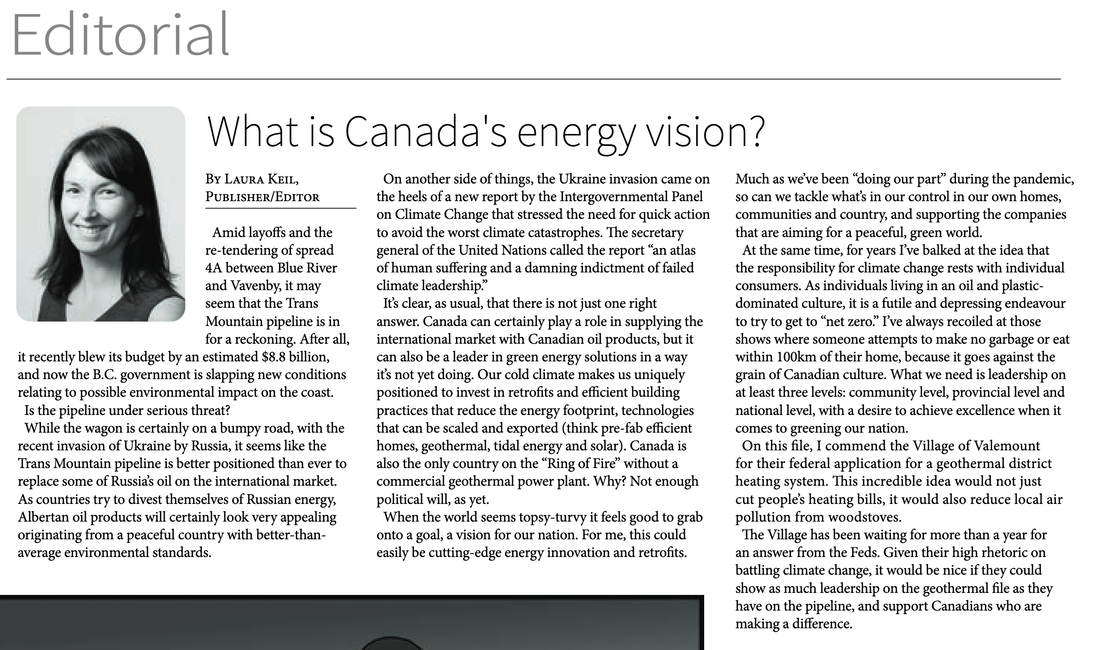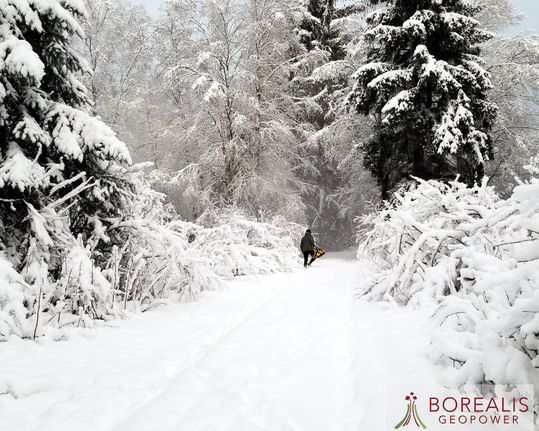|
The Terrace Standard wrote a story about the deal with Shell on the Fuel for Reconciliation project:
"One of the world’s largest energy companies is investing in the ongoing effort to determine if there’s a commercially-feasible geothermal energy development using hot underground waters at Lakelse Lake south of Terrace. Shell’s money with Kitselas Geothermal Inc., a partnership of the Kitselas First Nation’s Kitselas Development Corporation and Calgary-based Borealis GeoPower, will further determine the viability of drilling wells to a reservoir of hot water so that it can then be pumped up to be a source of heat or as steam to turn turbines to create electricity. Kitselas Geothermal has been active in the Lakelse Lake area for nearly 10 years, exploring the long-talked about possibility that the geological properties of the area that produced the hot water which once filled the pools at the Mount Layton Hotsprings development could also replace fossil fuels as a local energy source. In a typical geothermal project, water pumped up for conversion into a heat or energy source is then pumped back down for re-heating. Company president Alison Thompson said the joint development agreement with Shell will “de-risk” the project to determine the potential for more investment. “The drilling to be done … with Shell’s funding assistance is to intersect the M’Deek Reservoir with production sized wells. If the well tests look good, the wells could be used to produce geothermal energy,” she said. “The wells drilled previously were not intended to be used for production.” Current plans call for the drilling program to start within the next year. “We are nearing completion of the field work and data analysis necessary to site the wells in the drilling program,” said Thompson. Shell official Stephen Doolan said the Kitselas Geothermal investment is a first of its kind for the company. “We are exploring a number of lower-carbon business opportunities in Canada and geothermal is one of many,” he said. “The joint development agreement funding will advance activities to understand the potential for geothermal in the region.” Thompson would not disclose the location of the M’Deek Reservoir other than to say it was south of Terrace. Previously-released information indicates there was drilling on the west side of Lakelse Lake, across the water from Mount Layton Hotsprings and that licences had been obtained for drilling within an area of approximately 2,800 hectares on traditional Kitselas territory extending from south of Lakelse Lake and up the east side of Hwy37 South. Kitselas Geothermal earlier this year was also the recipient of $500,000 from the provincial government’s First Nations Clean Energy Business Fund, the maximum amount that the program can provide. That’s enabling the company to do necessary fieldwork. At the time the grant was announced, Thompson said it would also serve to attract further financing. At one time, a potential small liquefied natural gas project at the Skeena Industrial Development Park south of the Northwest Regional Airport had been tagged as a prospective customer for Kitselas Geothermal. But that project has since been shelved. The latest potential customer is Skeena Bioenergy, the pellet plant right next door to Skeena Sawmills. It sees value in an eventual pipeline from a geothermal hub to its plant so that heat from the water would replace natural gas in drying fibre before being turned into pellets and so reduce its carbon emissions. Shell is best known in the region as the majority owner of the LNG Canada liquefied natural gas export plant now under construction at Kitimat. And this would not be the first time a major energy company has expressed an interest and put money into geothermal energy at Lakelse Lake. In 2014 Enbridge struck a deal with the Kitselas First Nation and Borealis Geothermal to form a company as a foundation to explore the area. A $100,000 payment was then made to the province to secure sub-surface rights. At that time, Enbridge was embroiled in a battle with First Nations, environmental and other groups opposing the company’s effort to build oil-carrying pipeline from Alberta called Northern Gateway to a planned export terminal at Kitimat. That plan has since been cancelled. Records indicate the company formed by Enbridge, the Kitselas and Borealis Geothermal was dissolved in 2019." Read the article on the Terrace Standard site. Kitselas Geothermal Inc. (Kitselas Geothermal), a majority owned Indigenous company between Kitselas Development and Borealis Geothermal (Borealis), is pleased to announce that a Joint Development Agreement (JDA) with Shell Canada Energy (Shell Canada) takes effect on July 29, 2022. The JDA supports de-risking and appraisal of the geothermal resource in the Terrace, British Columbia area, after which each party will take a decision on further development. Through entering into this agreement, Kitselas Geothermal and Shell Canada hope to build greater understanding of the potential for geothermal energy and support development of renewable green energy in Northwest BC, including ‘direct-use’ of the heat.
Kitselas Geothermal’s vision is to supply renewable, industrial heating alternatives in the Terrace area. Economic self-determination for Kitselas First Nation via long-term heat purchase agreements is a goal of the project. Kitselas Geothermal’s chair, Dr. David Try, PhD, says, “First Nations, for thousands of years, made use of ‘direct’ geothermal energy in this region. Exploring the potential for commercial energy - clean, sustainable, responsible, and reliable is a natural step.” Kitselas Geothermal’s CEO, Alison Thompson, says, “The opportunity to continue this project, to test, derisk and progress the geothermal heat potential in the Terrace region under this JDA is a key milestone. We are proud of the significant sub-surface, regulatory and stakeholder relations contributions that Borealis has made as the project’s development and exploration technology partner in Western and Northern Canada’s unique geologic setting. Today marks the point in the project where Kitselas Geothermal and Shell Canada will begin to work and learn together in this project.” Shell Canada’s Geothermal Business Opportunity Manager, Sarah Kassam, says, “Globally, Shell is investing in renewable energy as part of our Powering Progress strategy, which includes a target to become a net-zero energy business by 2050. Through signing the JDA with Kitselas Geothermal, Shell Canada hopes to build a greater understanding of the potential for geothermal energy and to support renewable energy development with Kitselas Geothermal in the Terrace, BC region.” About Kitselas Geothermal: Kitselas Geothermal is controlled by Kitselas Development Corporation, the economic arm of the Kitselas First Nation. Kitselas First Nation, through Kitselas Geothermal, is proudly positioned to provide near-term clean energy solutions into the Terrace region. Borealis Geothermal is their technology partner and minority shareholder: www.kitselasgeo.ca About Borealis Geothermal: Borealis is Canada’s leading expert in fault-controlled geothermal energy and provides development support to projects in this and other geologic settings in Canada: www.borealisgeothermal.ca About Shell Canada: Shell Canada is an integrated energy company in Canada with all of Shell’s global businesses represented, including Upstream, Integrated Gas, Downstream, and Renewables and Energy Solutions. That means we do everything from exploration, gas production, refining and manufacturing, to providing fuels and developing low-carbon energy solutions for our customers: www.shell.ca On July 14th, B Labs, a worldwide company that awards companies with B Corporation certification, awarded Borealis the title "Best for the World 2022."
Best of the World means that a company places in the top 5% in the 5 B Impact Assessment areas (community, customers, environment, governance, and team-mates) worldwide. We are thrilled to have earned this title. We are constantly striving to make the world a better place and are grateful to have earned that recognition. Click here to view Borealis's B Corp Page. Click here to view the full Best for the World 2022 list. About Alberta Tech has published an interview with Borealis CEO, Alison Thomson, about geothermal energy. The interview covers Thompson's career and the history of Borealis and shines a light on geothermal and Thompson's environmental philosophies. Read the summary on About Alberta Tech's website or watch the video here: Borealis CEO Alison Thompson was featured on the "Navigating to Net-Zero" episode of the podcast Shift by Alberta Innovates. In the episode, which was meant to promote the geothermal energy panel at Inventures 2022, Thompson talked about geothermal energy in Canada, the differences between geothermal power and geothermal heating, and more. Listen to Thompson talk about geothermal heating, Borealis's projects and more:
"Geothermal Whitecourt projects not currently ‘economically viable’: Report" by Brad Quarin
Now is not the time to develop geothermal heat or electricity projects in the Whitecourt area, according to a Geothermal Development Feasibility Study. Town planning director Jennine Loberg spoke on the study at Whitecourt council’s policies and priorities committee meeting Monday. “Unfortunately with the current market conditions, the economics of using geothermal are not quite there,” Loberg told council. “However, the good news is that there have been several spots of hot sedimentary aquifers confirmed for our area. “I think having this information publicly available is going to increase the discussions on the potential for our area, and increase the likelihood of a project that is a good fit for geothermal.” According to council’s agenda package, high capital costs for geothermal projects mean using geothermal direct heat instead of natural gas wouldn’t meet the 10 per cent rate of return needed for investment. Loberg said grants and lower drilling costs could address some of the economic concerns to make geothermal projects feasible in the area. The potential for geothermal development in Whitecourt and Woodlands County became evident through local oil-and-gas wells showing hot subsurface temperatures, according to the study. “It (geothermal development) is something that previous reviews had found potential in, and we were identified as a potential hotspot,” Loberg told council. Geothermal projects involve less land footprint and produce little greenhouse gas emissions, the study states. Whitecourt and Woodlands had secured an Alberta Community Partnership grant to hire Borealis GeoPower in 2020 to complete the study, according to town administration. The company finished the study in July 2021. Whitecourt and Woodlands councillors reviewed the results during a Feb. 23 workshop, and the report is now available at whitecourt.ca/reports. Loberg told council Monday that administration applied for a federal Smart Renewables and Electrification Pathways Program (SREP) grant for further site investigation but was unsuccessful. Abigail Lixfeld, a Natural Resources Canada senior director, wrote in a letter to the town that the program received 234 applications from across the country, and the program budget couldn’t accommodate all. Coun. Braden Lanctot’s motion to accept the study was carried. Study looks at serving three local areas The study showed hot sedimentary aquifers were located below both the town and county. Some reservoir temperatures reached as high as 140 C, Loberg told council Monday. The three areas within Woodlands County with the highest energy demand are the Town of Whitecourt, a Woodlands area west of town and another southwest of town, according to Borealis GeoPower. There are eight formations (hot sedimentary aquifers) at differing depths that could serve these areas that the study explored. Some, like the Nisku Formation (which has depths of 2.1 to 2.25 kilometres), are located underneath all of Woodlands County. Other formations can be found in certain local areas. The Gilwood Sandstone is beneath the Whitecourt area at depths of 2.65 to 2.75 km while the Swan Hills Formation can be found in southwest Woodlands and north of Whitecourt, and reaches 123 C in places. Of the three areas, the study found a geothermal heating project is most economically viable in Whitecourt. This is due to its high demand and potential to access seven of eight formations the study explored, with temperatures in Whitecourt’s targets varying from 45 to 120 C. For example, the Viking Sandstone, which is shallower (1,250 metres) and cooler (45 to 57 C) than the other formations, could be used for direct use heat in the town and nearby business parks, according to Borealis GeoPower. Southwest Woodlands County around Highway 32 has greater heat of 54 to 125 C that could “serve higher temperature industrial purposes,” Borealis GeoPower states. The area west of town doesn’t currently have great heat demand, Borealis GeoPower notes. However, the study states it may see greater energy demand due to the possible development of a business park, with the area having potential for electricity generation. Other formations looked at included the Nordegg formation in western Woodlands County that could also be used as a direct use heat reservoir, and the Eldon Sandstone on the northwest of Woodlands. The Leduc Formation in the northeast and southwest of Woodlands County is distant from areas of high energy demand but has 111 C temperatures, the study notes. The Village of Valemount and the combined efforts to resume the development of our Sustainaville project were commemorated by Laura Keil in her editorial, "What is Canada's energy vision?", for the Rocky Mountain Goat. Keil called the project "a brilliant idea" and invited the Canadian government to "show as much leadership on the geothermal file as they have on the [Trans-Mountain] pipeline, and support Canadians who are making a difference."
Written by Rod Link. Published January 15th, 2022, by the Terrace Standard:
Geoscience work on the potential to pump super hot subsurface water from near Lakelse Lake so that heat extracted could replace fossil fuels as an energy source in the area continues thanks to a $500,000 grant from the provincial government. Announced Jan. 13, the money furthers what is approaching seven years of probing by Kitselas First Nation-owned Kitselas Geothermal and Borealis GeoPower of Calgary of the potential for an income producing industry. When brought to the surface, the superheated water’s steam can be used to turn electricity-generating turbines or pumped to clients who use the heat from the hot water as needed. “Basically just like a hot water radiator heating system in a house, the hot water is piped to where [the heat] is needed,” explained David Try, the chair of Kitselas Geothermal. “The cooled water returns to the heat source/geothermal system.” The $500,000 from the provincial government’s First Nations Clean Energy Business Fund is the maximum amount that the program can provide. It’s also viewed as something that can prompt further investment by other agencies or investors, acknowledged Borealis president Alison Thompson. Both Kitselas Geothermal and Borealis have emphasized the prospect of clean energy alternatives to fossil fuels to help meet the province’s overall emissions reductions effort as well as local employment and economic spinoffs. Some of the ongoing field work to better map out where the superheated water is located involved seismic testing using a technology that did not require clearing trees. The Lakelse Lake area has long been regarded as having the potential for a viable geothermal project, something Kitselas Geothermal and Borealis began exploring more in depth in 2014 with drilling following in 2018 on the west side of Lakelse Lake across from the Mount Layton Hotsprings location. Should an eventual project be feasible, Kitselas Geothermal and Borealis already have a potential customer in Skeena BioEnergy’s pellet plant. It sees value in an eventual pipeline from a geothermal hub to its plant so that heat from the water would replace natural gas in drying fibre before being turned into pellets and so reduce its carbon emissions. The City of Terrace was also attracted to the potential and last summer provided support letters for applications by Kitselas and Borealis for additional government grants through the provincial government’s CleanBC Industry Fund. “We view this as a positive step forward in an exciting and promising project for Skeena,” said Roger Keery, the president of Skeena Sawmills Ltd, about the $500,000 grant. Kitselas Geothermal and Borealis are expected to hear if their application is successful within several months. On January 13, 2022 the Honourable Murray Rankin, the B.C. Cabinet Minister of Indigenous Relations and Reconciliation, announced funding for Kitselas Geothermal Inc.’s Fuel for Reconciliation project via a First Nations Clean Energy Business Fund grant. Borealis GeoPower is an affiliate of KGI and minority owner of the 'Fuel for Reconciliation' project in which the Kitselas Development Corporation owns the controlling stake.
Borealis is grateful to be in collaboration with Kitselas Geothermal who has aligned itself with the BC First Nations Climate Strategy and Action Plan. A Guiding Principle of the Plan is “Collaborate and develop true partnerships between First Nations in BC and governments, the private sector, other Indigenous Peoples, and our society as a whole to effectively address the climate emergency.” The proposed geothermal district heating system, Fuel for Reconciliation, would build capacity, resiliency and self-sufficiency in the BC North Coast region. Fuel for Reconciliation seeks to decarbonize industries in and around Terrace by providing a clean and affordable energy alternative to fossil fuels. The clean energy transition is an act of guardianship that will protect the North Coast from climate change for generations to come. Click here to read the official press release. Alison Thompson, our CEO, describes how hydrocarbons are a valuable building block in the economy and value chain in her interview. However, the unnecessary combustion of fossil fuels creates harmful emissions that pose a risk. Thompson encourages people to use a thought experiment where they choose to use or not to use fossil fuels and instead choose a type of renewable energy that is abundant and non-emitting. The energy transition does not have to be painful, and geothermal energy is here to help. Click here to visit TheFutureEconomy.ca's page. |
Archives
November 2023
|
Contact US
|
TAKE OUR FUEL SWITCH ASSESSMENT:
|





 RSS Feed
RSS Feed

